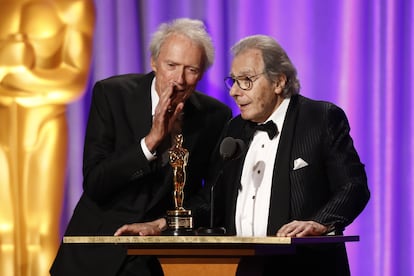Lalo Schifrin, one of the greats of jazz and audiovisual composition, died last night in Los Angeles, victim of pneumonia, at 93, according to one of his children, Ryan, in a statement. The Argentine’s name may not be as popular as that of other jazz pianists or distinguished soundtrack creators, but probably the Buenos Aires had more talent than they, confirmed both in pure jazz recordings and in the scores that were part of The indomitable legend, Bullitt, Enter the Dragon, Harry the Dirty, the King of the Game o Tango, And in series like Starsky y Hutch o Mannix. And of course, the television series and subsequent saga in the cinema Mission: Impossible: His is that musical explosion that combines action and tension. Six times Oscar candidate, received the statuette of honor in 2018 from Clint Eastwood. In addition, he won four Grammy awards (and a fifth in the Latin Grammy), and was a candidate for four Emmy and once to Goya, in this case by the soundtrack of Berlin Blues (1998), by Ricardo Franco.
However, in one of his concerts, at the 1998 San Sebastián Festival, when he directed Euskadiko Orkestra at the Anoeta velodrome before the projection of Tango, From Carlos Saura, whose soundtrack was author, Schifrin told this journalist: “I had two luck: my father’s support and meet Dizzy (Gillespie).” And about his famous tune for the series Mission: impossible, Created in 1966, he said: “It was very easy, and I did it without seeing an image of the series. Actually, I composed it in a few minutes. The producer asked me for something exciting, and so it came out.”
Boris Claudio Schifrin was born in Buenos Aires in 1932. His father was a symphonic violonist, and it was he who put him in front of a piano at age six. One of his teachers was Enrique Barenboim, the father of the orchestra director Daniel Barenboim. At 16, some fellow studies put his first jazz album: “It was like a lighting, a very important moment in my life. I became jazz,” he recalled in a 2008 interview for the Archive of American Television. However, jazz was considered “immoral” at that time, and that is why Schifrin listened to him in Buenos Aires.
At 20 years he traveled to Paris, where he finally enjoyed jazz (at that time he was one of the capitals of this genre) and studied at the city’s conservatory. On his return to Buenos Aires he set up his own big band, He began to compose for Cine, and his great meeting arrived: he met at a reception at the United States embassy in Argentina to Dizzy Gillespie, who on that tour of Argentina was accompanied by Quincy Jones, and they two, more Schifrin and the renovator of Tango Astor Piazzolla (which was already a great figure) acted together.
Encouraged by Gillespie, Schifrin moved to New York in 1958. He won his life playing the piano in a Mexican restaurant, then Xavier Cugat hired him to write arrangements for his show, and finally, in 1960 he acted with Gillespie in the album Gillespiana. He also dedicated himself to the Jazz album arrangements of Stan Getz and Sarah Vaughan.
In 1963 he took another turn to his career and left for California. This stage as a series and films composer began. His first Hollywood work was for the film set in Africa Rhino!(1964), while working other genres, such as the French The felines (1964), by René Clement.
Thus innumerable soundtracks, arrangements for film and television came, and address for recordings, while combining that work with the orchestras address in all over the world. In addition, in 1987, he was appointed musical director of the Paris Philharmonic Orchestra, formed to record music for films, and held the position for a five years.
If on television he left his mark on Mannix, Mission: Impossible o Starsky y Hutchin cinema his talent for action was associated with the entire saga of Harry the dirty (Eastwood became one of his friends), to the saga of Rush hour, to the persecutions of Bullitt, to the thrilling rhythms of The coup 2, the fox, the legend of the indomitable, Brubaker, the king of the game, Thx 1138 (George Lucas’s first movie), Call to a reporter, the fourth protocol, here, a friend (para Billy Wilder), Terror in Amityville, the contest, the trip of the cursed, the bridge of San Luis Rey And many more. Even Bruce Lee, who trained in his gym in Hong Kong with the music of Mission: impossible, hired him for his masterpiece Dragon operation (1973). In return, along with his salary, Lee gave the first martial arts lessons to the musician.
In turn, he did not stop recording and composing jazz records, he redirected his melodies towards the funk, and in 1993 he began a series of albums entitled Jazz Meets the Symphony. Schifrin continued working even after confinement (which passed at his home in Beverly Hills, which had previously belonged to Groucho Marx), when he composed the camera pieces Modern String Quartets, that incorporate Argentine rhythms such as tango, malambo and chacarera. Last April his Symphony Work premiered in Buenos Aires Long live freedom! next to the National Symphony Orchestra.
With the Oscar in his hand, in his thanks speech, dotted with jokes with Eastwood, who looked absolutely happy, Schifrin recalled that with five years he was with his parents to watch a horror movie: “And I understood that without music it was not scary.”

